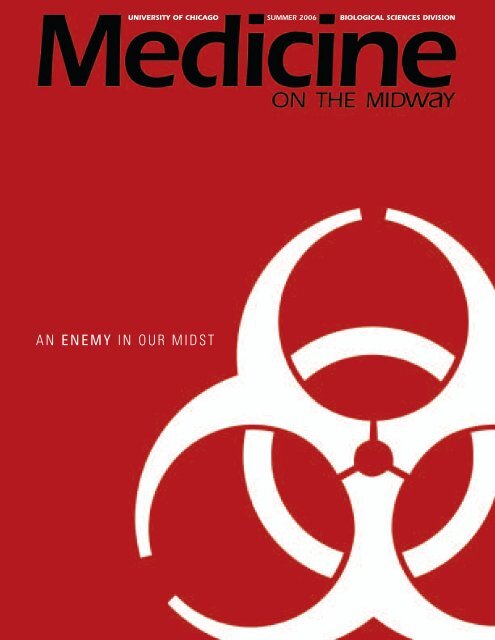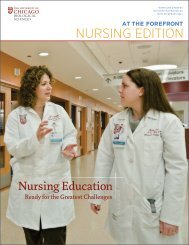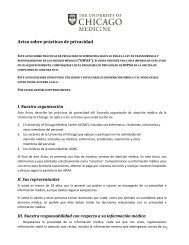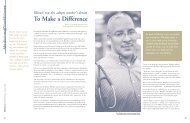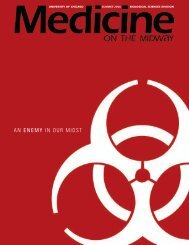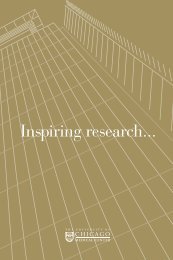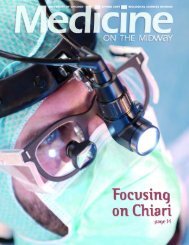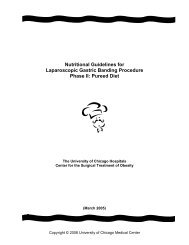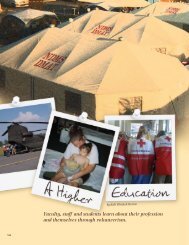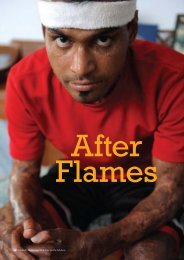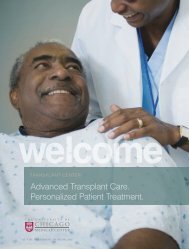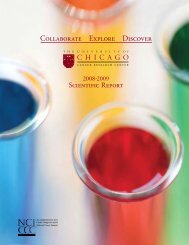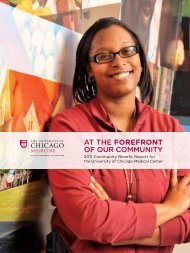AN ENEMY IN OUR MIDST
Medicine On the Midway - University of Chicago Medical Center
Medicine On the Midway - University of Chicago Medical Center
You also want an ePaper? Increase the reach of your titles
YUMPU automatically turns print PDFs into web optimized ePapers that Google loves.
<strong>AN</strong> <strong>ENEMY</strong> <strong>IN</strong> <strong>OUR</strong> <strong>MIDST</strong>UNIVERSITY OF CHICAGO SUMMER 2006 BIOLOGICAL SCIENCES DIVISION
Medicineoff theMidwayThe Deanfor StudentsPhoto by Dan DryJOSEPH J. CEITHAML, SB ’37, PHD ’41by Frank StephensonOn the occasion of a beloved dean’s90th birthday, it is fitting that auniversity devote some words tocommemorate him.But this isn’t exactly a story about Joe Ceithaml. This storyis more about what Ceithaml was about: his students.And they certainly are his. In a way that is difficult to imaginethese days—when schools devote entire departments to studentrecruitment, admission, financial aid and career counseling—Ceithaml served all those roles and one besides: He was a tireless,passionate advocate for the proposition that med school studentsshould focus on learning their occupation, not fall victim to apreoccupation with meeting tuition.“Most of us would neverhave been able to afford to go to medical school, and we knewhe was always coming up with loan funds and scholarship funds,”said Everett Given, MD ’59, in a 1994 Medicine on the Midwayarticle titled “A Retiring Man.” Given is one of the nearly 3,000physicians and 1,500 research biologists to earn degrees duringthe 35 years Ceithaml served as dean of students in theBiological Sciences Division and the Medical School.“He knew students couldn’t make it if they had to worryabout finances,” Given said. “He made it his business to know thestudents and their families. And when my two sons graduatedfrom Pritzker in 1980, he was still doing that. He’s truly aremarkable man.”“Originally, I didn’t want my birthday to be abig deal. But when I was informed that it wouldbe a means of raising funds for students, then Iembraced it. This would again be what I’d beendoing all along.”Even today, nearly a dozen years after his retirement,Ceithaml’s dedication to that principle is as firm as it was whenhe took the job in 1951. At his insistence, a yearlong series ofalumni tributes nationwide, culminating in a June 3, 2006,celebration on campus, has been devoted to raising money forthe Joseph J. Ceithaml Scholarship Fund. The fund was createdin 1999 by alumni to honor Ceithaml’s lifetime of dedicationto the university.“Originally, I didn’t want my birthday to be a big deal,”Ceithaml said. “But when I was informed that it would be ameans of raising funds for students, then I embraced it. Thiswould again be what I’d been doing all along.”34
“The party part of it I could do without, but to raisemoney for the scholarship fund, I’ll do virtually anything thatneeds to be done because I know how much it meant to a lot ofstudents when they were coming through,” he said. “I can’t thinkof one instance where I let a student take time off to work. I toldthem, ‘I’ll find money, loan funds with no interest, and you takeall the time you want to pay it back, but pay it back so the nextgeneration can have those funds.’ And that’s what they did.”A LIFETIME COMMITMENTJoseph J. Ceithaml’s affiliation with the University of Chicagospans more than 70 of his 90 years. Born in 1916 into a Chicagofamily of Czechoslovakian immigrants on the southwest side oftown, Ceithaml graduated from Lindblom High School asvaledictorian of his class. In 1933, he became the first of hisfamily’s six children to go straight into college. At Chicago hesoon discovered a passion for biochemistry, and in 1937 with theworld on the brink of war, he earned a bachelor’s degree in thefield and quickly jumped into a doctoral program, completing itjust weeks before Pearl Harbor.Ceithaml immediately became one of thousands of youngresearchers swept up in the war effort. Instead of a foxhole,Ceithaml fought from a biochemistry lab, recruited for a malariaresearch project run by the Office of Scientific Research andDevelopment of the U.S. War Manpower Commission. It wasan exhilarating time for young Ceithaml: Not only was he partof a national effort to fight a familiar dreaded disease with betterdrugs, but on a personal level he had hit his stride as well,marrying Ann Bednarik in 1942, a fellow gymnast whom he’dknown since high school.But it was the chance occasion of substituting for a Chicagopre-med advisor called off to war that made all the difference inCeithaml’s career. What was supposed to be only a summer-longstint turned into two years. It soon dawned on Ceithaml that ifhe didn’t escape from these new administrative duties—which herealized he enjoyed far more than he’d imagined—his dreams of alife in teaching and research would never materialize. So in 1948he and Ann left Chicago for a post-doctoral fellowship at Caltech,where he worked with George Beadle, a visionary geneticist whoin 1958 would share the Nobel Prize in medicine—three yearsbefore being named president at Chicago.But within two years, Ceithaml was back on his favorite campus,doggedly pursuing twin ambitions to become not only a topdrawerresearcher in biochemistry but as a teacher as well—and hesucceeded. In 1950, the university handed him a Quantrell Award,the highest honor Chicago bestows on undergraduate teachers.When Lowell Coggeshall, the dean of the BSD at the time,offered him the job of the med school’s dean of students,Ceithaml didn’t bat an eye. He agreed to take the job on theconditions he could still teach and do his research.That was 1951. To his dismay, Ceithaml soon realized that hishallmark energy and perseverance had limits. Try as he might, hecouldn’t keep all three balls—teaching, research and his new job—in the air at once. Something had to go. First it was teaching,then, two years later, his beloved research. Looking back, Ceithamlsaid he has no regrets at all about the choice he made. “If I had itto do all over again,” he said, “I’d do it the same way.”THE DE<strong>AN</strong> FOR STUDENTSWith his no-nonsense, patrician demeanor, accented by aperpetual crew cut and a militarily correct posture, Ceithamlexuded the kind of professionalism and serious devotion to thetask at hand that he expected every one of his new charges toadopt. But he always did so with a firm handshake and a twinklein his eyes.Try as he might, he couldn’t keep all threeballs—teaching, research and his new job—in the air at once. Something had to go. Firstit was teaching, then, two years later, hisbeloved research.If students didn’t already know it when they first set foot oncampus, they soon learned that when it came to finding realhelp that they could count on, Ceithaml was the man.Testimonies to his seemingly limitless ability to get thingsdone, and in the most effective way, abound. Many alumnidescribe his remarkable ability to connect with them throughcompassion. Students picked up on his sincerity and determinationto use his position to help them make the bestadvantage of their time on campus.35
Photo by Dan DryMedicineoff theMidwaySusan Shumway, MD ’60, now a retired pediatrician in Encino,Calif., fondly recalled her first encounter with Dean Joe. “He spokewith the students, not at us, and he always spoke from the heart,”she said. “I think many times, he knew more about what we reallyneeded than we knew ourselves. You could go to him with anyproblem you might be having and he was very reassuring, verycompassionate.”Martin “Marty” Pops, MD ’64, not only credits Ceithaml withhis medical training, but his career that took a similar path. Whilefinishing his training in psychiatry at University of California-LosAngeles, Pops found himself at the same crossroad Ceithaml had facedin 1950—to stay in administrative work or pursue a career in research.An anguished Pops sat down with Ceithaml at a professional meetingand revealed his dilemma.“He told me, ‘Marty, if you want to commit academic suicide,you might not want to [take the administrative job]. Because ifyou do, and do it right, you’re just not going to have much timeto do anything else,’” Pops recalled.Now retired in Los Angeles, Pops went on to spend 31 years onthe UCLA faculty, stepping down as dean of students for its medschool in 1996. He said that it was a rare day in his long career asdean that he didn’t reflect on how Joe Ceithaml would have handleda particular situation.“Over the years, I’d see Joe at professional meetings, and he’dalways say it was the students who made him look good,” Popssaid. “He was always thinking about the students, about how theyneeded to learn to take the focus off themselves and put the focuson patients. He taughtus that this should beour guiding principle.”As for Ceithaml’sfamous influence overstudents’ lives atChicago, Pops hadheard rumors evenbefore he applied foradmission. He soonlearned just how muchon the mark thoserumors were.Applying fairly late inthe admissions pipelinefor the entering class of1960, Pops interviewedwith Ceithaml on aSaturday morning beforehopping a plane to Cleveland to visit some family members.Ceithaml had concluded the interview by saying he’d have to runPops’ application by the school’s admissions committee. PopsJoe Ceithaml with his second wife, Mildred,whom he married in 1989. He also has twochildren: Lenore, who practices immigrationlaw in San Diego, and Eric, chief of pediatriccardiovascular surgery at the University ofFlorida at Jacksonville.thanked him, gave him the Cleveland address of where he’d bestaying for a few days, and left.When Pops arrived at the Cleveland airport that evening, hewas greeted by a grinning aunt and uncle frantically waving atelegram. It was from Ceithaml, announcing Pops’ acceptancefor the class of 1960. In recounting the tale, Pops chuckled.“There’s no way the admissions committee could have beencalled from the time I’d interviewed that morning,” he said.“This bore home the rumors that it was Joe Ceithaml who madeall the decisions. At the time, I don’t think this was all thatunusual in med schools. But I know that back then at UC,Joe Ceithaml was the admissions committee.”Ceithaml fondly remembers Pops and so many others, evenif their names don’t spring to mind like they once did. Once hecould call the first name of nearly every student on campus. Itwas a trademark characteristic that made each student feel special.“I took my job seriously, but I never took myself all thatseriously,” Ceithaml said with a chuckle. “I like to think of myselfas being as good a dean for students as I was dean of students.”LIFT<strong>IN</strong>G MONEY WORRIESA product of the Depression, the son of a machinist for theBell Telephone Company, Ceithaml instinctively understood howfinancial hardships commonly threatened or doomed altogetherthe med school ambitions of many promising students. One ofthe first items of business he took up upon becoming dean ofstudents was to establish a loan fund to help students in direfinancial need. Ceithaml started with $25,000 in the fund in1952, and by the time he stepped down 35 years later, it hadgrown to more than $6 million.When Ann, his wife of 43 years, died of cancer in 1985, he setup a separate loan fund in her name to honor her for all the yearsshe supported his career. To this day, the fund offers interest-freeloans to qualified students, while the other funds continue to offerlow-interest loans.Whenever he could, Ceithaml would augment his loan funds withscholarships and even part-time jobs that he’d arrange for students.Ed Comay, MD ’57, also a retired Los Angeles psychiatrist,remembers the latter well. Even with support from the G.I. Bill,Comay said he couldn’t make ends meet once he enrolled, so hewent to Ceithaml looking not for a handout but a job. He soonfound himself working part-time in the school’s medical chemical lab.“I got a room in the hospital and a hundred dollars a month,which paid for my meals,” Comay said. “So between this joband the G.I. Bill, that’s how I made it through school.”Ceithaml’s knack for arranging scholarships for worthyrecipients was renowned. Two of the university’s mostdistinguished medical school alumni fully credit a Ceithamlscholarship for their careers. The spring issue of this magazine36
Photos from left: Ceithaml (far right) receives the Quantrell Award for Excellence in UndergraduateTeaching in 1950 from Chancellor Robert Hutchins (second from left); Ceithaml with his students;the dean at a reunion in 1991.featured the story of one, Russ Zajtchuk, MD ’63, a cardiothoracicsurgeon who went on to become one of the world’sforemost authorities in telemedicine. One of Zajtchuk’s fellowstudents, Marvin J. Stone, MD ’63, is now director of theWhenever he could, Ceithaml would augmenthis loan funds with scholarships and evenpart-time jobs that he’d arrange for students.Sammons Cancer Center at Baylor University. Stone alsofinished school largely thanks to a scholarship arranged byCeithaml, whom he names as one of the two most influentialfigures in his career.When he hears such grateful words today, Ceithaml dismissesany suggestion that his efforts are a sign of magnanimity.“No, itwasn’t magnanimous at all, it’s just what should have been doneall along,” he said matter-of-factly. “I was always interested infinding funds—whether loans, scholarships or part-time jobs—for students to be able to complete their studies without havingto drop out of school.“As a consequence, I think there’s a fair number of alumniwho benefited from the monies we found them, and theyremember that. They’re still sending in their support [to themed school] and have repaid this aid many, many times over.”Ceithaml is troubled by what he calls the “outrageous” costof getting a good med school education today, citing a recentestimate that a Pritzker student who started in 2005 will needupwards of $250,000 to graduate. This financial mountain castsa long shadow over his lifetime crusade to lift money worriesfrom students’ backs so they can concentrate on becominggood doctors.“When I was dean, I strongly urged students to avoid havingpersonal debt loads of more than $25,000 by the time theygraduated,” he said. “This way, they wouldn’t be so temptedto go into fields that paid higher salaries, just to get their debtspaid, instead of doing something they really wanted to do.”Today, it’s not unusual for grads to leave a four-year medschool program owing $140,000 or more in various studentloans. “This kind of debt puts an enormous pressure on studentsto choose between doing the things they want to do and thingsthey think they have to do, and I find that unfortunate,” he said.But what hasn’t changed, in Ceithaml’s view, is what medschool students have always needed far more than money.Regardless of how bright they are, young people who areconsidering medical careers need not apply if they aren’t fullycommitted to tackling the tough intellectual work.“It’s never been enough to want to go to med school,” he said.“You’ve got to be committed, and that’s something that’s neverchanged and I don’t think ever will.”Fittingly, Dean Ceithaml has asked that gifts for his 90th birthdaycelebration be directed to the Joseph J. Ceithaml Scholarship Fund.For more information about this fund, about Ceithaml’s remarkablelife and career at the University of Chicago, and about the Junecelebration, visit http://bsdalumni.uchicago.edu/ceithaml/ orcontact the Medical & Biological Sciences Alumni Associationat (888) 303-0030.37


